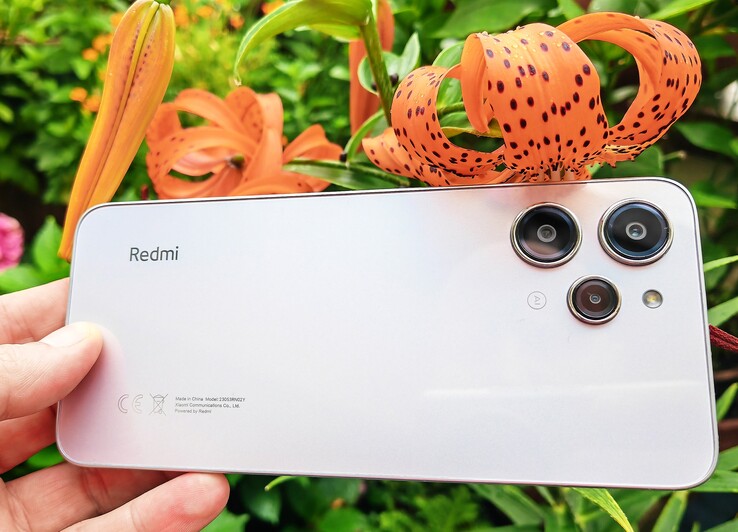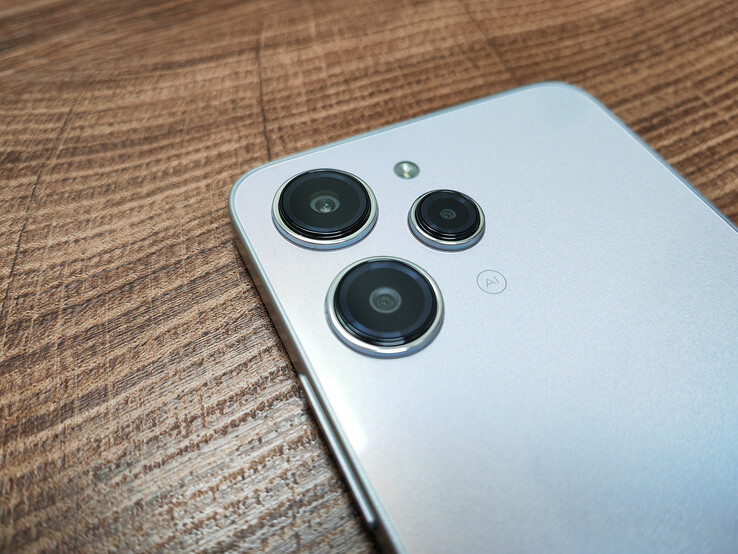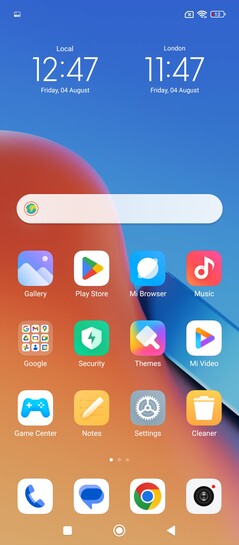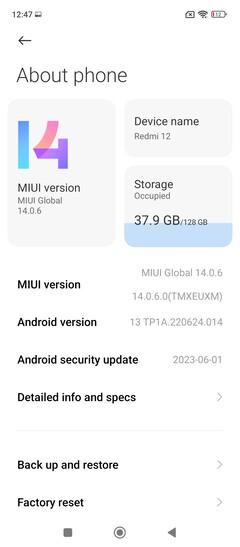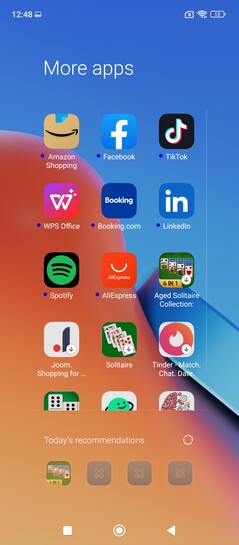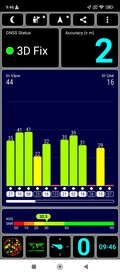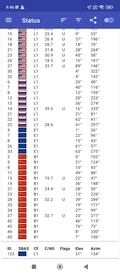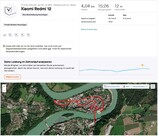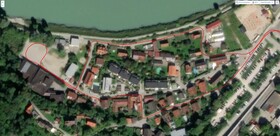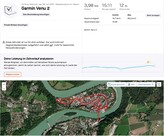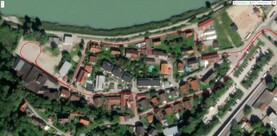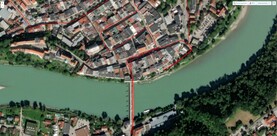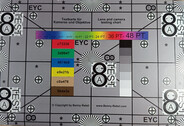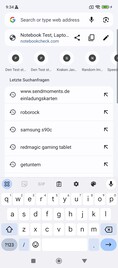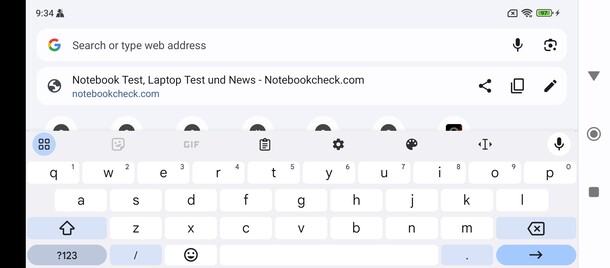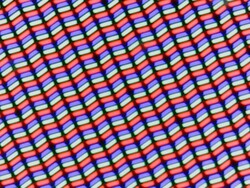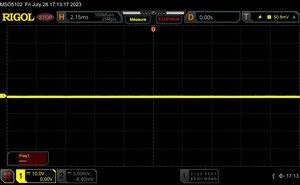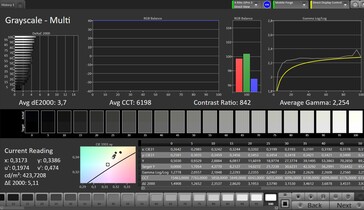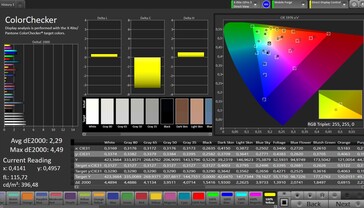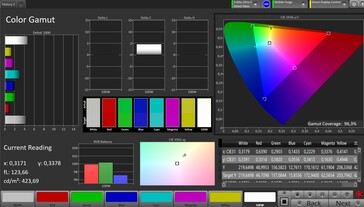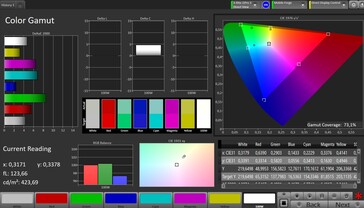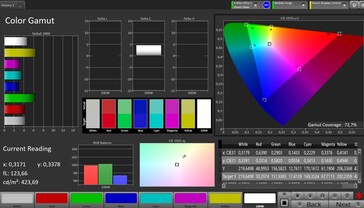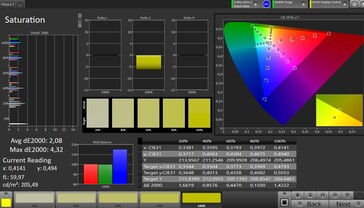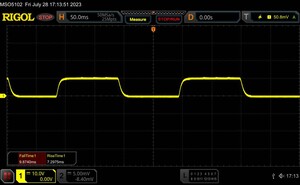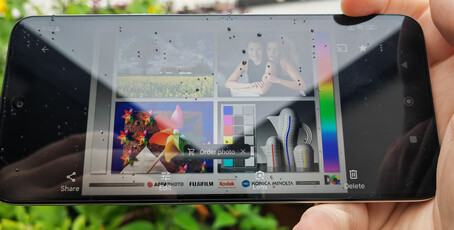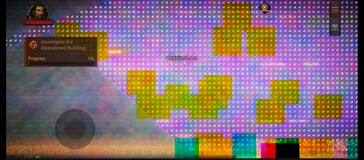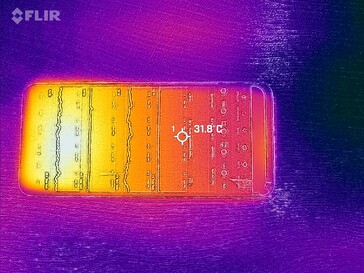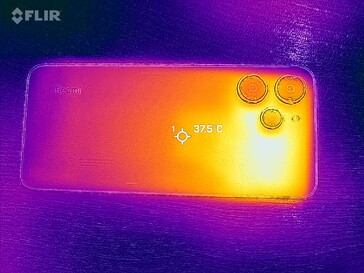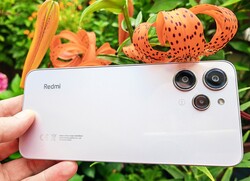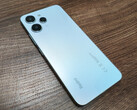Xiaomi Redmi 12 smartphone review – A flexible camera system for under US$200
Xiaomi's Redmi series traditionally includes cheaper phones that often have a few special features to offer. The Chinese manufacturer markets the Xiaomi Redmi 12 as having limited protection against water as well as flexible cameras. And at the same time, the phone is supposed to be available for under US$200, while also still offering quite a bit of storage space.
On the other hand, there are lots of other very strong competitors within this price range and more often than not, you have to end up making a few compromises if you decide to purchase such a cheap phone. In this review, we will take a closer look at what you might have to forgo as a potential user of this device.
Possible competitors compared
Rating | Date | Model | Weight | Drive | Size | Resolution | Price |
|---|---|---|---|---|---|---|---|
| 79 % v7 (old) | 08 / 2023 | Xiaomi Redmi 12 Helio G88, Mali-G52 MP2 | 198.5 g | 128 GB eMMC Flash | 6.79" | 2460x1080 | |
| 81.7 % v7 (old) | 06 / 2023 | Xiaomi Redmi Note 12 5G SD 4 Gen 1, Adreno 619 | 189 g | 128 GB UFS 2.2 Flash | 6.67" | 2400x1080 | |
| 75.9 % v7 (old) | 07 / 2023 | Samsung Galaxy A14 LTE Helio G80, Mali-G52 MP2 | 201 g | 64 GB eMMC Flash | 6.60" | 2408x1080 | |
| 78.7 % v7 (old) | 05 / 2023 | Nokia G22 T7200 (T606), Mali-G57 MP1 | 195 g | 64 GB UFS 2.2 Flash | 6.52" | 1600x720 | |
| 79 % v7 (old) | 03 / 2023 | Motorola Moto G23 Helio G85, Mali-G52 MP2 | 184.3 g | 128 GB eMMC Flash | 6.50" | 1600x720 |
Case – Sleek glass case
The back and front of the Xiaomi Redmi 12 is made from Gorilla Glass - although, Xiaomi hasn't specified which version. Due to the phone's low price, it is safe to assume this is an older variant, which means you shouldn't rely on complete breakage resistance. Design-wise, the Redmi phone looks really nice - our silver test sample shimmers in lots of different colors and the particles under the glass sparkle.
The sides feature a plastic frame, which is available in black, silver or light blue. The cameras each have their own indentation within the case, meaning there is no singular border around the camera module.
Xiaomi has defined the case as being IP53 certified, so it is relatively well protected against dust, but it is only water resistant and not waterproof. You shouldn't submerge the phone underwater. The back is very stable under pressure and doesn't have any give. Medium pressure on the front penetrates through to the screen's liquid crystal. The Xiaomi phone can hardly be twisted, but it cracks slightly from time to time when you try to do so.
Features – Lots of storage for your money
The Xiaomi Redmi 12 is available in two storage variants:
- 4 GB RAM / 128 GB storage: US$170
- 8 GB RAM / 256 GB storage: US$187
Internationally, you might also be able to find the smaller storage variant with 8 GB RAM.
Thankfully, you don't have to miss out on NFC, meaning you can also utilize payment services such as Google Pay. If you enjoy listening to radio on the go and don't want to use up any of your data, then you can make use of the phone's built-in FM radio.
Another unique feature is the Redmi 12's infrared sensor which allows you to use the smartphone as a remote control for your TV.
microSD card reader
The phone doesn't have a designated microSD slot, so you'll have to decide whether to utilize two SIM slots or to use one for a SIM and one for a microSD. The card reader accepts microSDs with up to 1 TB of storage - although, in our copying test using the reference card Angelbird V60, it proved to be a bit slow.
| SD Card Reader - average JPG Copy Test (av. of 3 runs) | |
| Samsung Galaxy A14 LTE (Angelbird AV Pro V60) | |
| Xiaomi Redmi Note 12 5G (Angelbird AV Pro V60) | |
| Motorola Moto G23 (Angelbird V60) | |
| Nokia G22 (Angelbird V60) | |
| Xiaomi Redmi 12 (Angelbird V60) | |
Cross Platform Disk Test (CPDT)
Software – Android 13 ex works
The Redmi 12 comes with MiUI as an interface which relies on Android 13 - although, it changes the system quite a bit. Fans of pure Android should probably try out MiUI before buying the device, to see if you are okay with all of these changes.
Lots of apps come pre-installed, including third party sponsored apps. At times, ads are shown as part of the system itself, for example on the lock screen or while installing apps.
At the time of testing, the latest security patch was from June 2023, so still relatively up-to-date. In the past, Xiaomi has even provided its cheaper phones with at least 2 years of Android updates and has released regular security patches over the course of many years.
Communication and GNSS – The Redmi 12 with precise locating
With WiFi 5 and data rates of up to 376 MBit/s during our WLAN test using the reference router Asus ROG Rapture AXE11000, the Redmi 12 proves to represent its price category just as expected.
Close to the router, we had full WLAN signal and websites were loaded relatively quickly. With a distance of 10 metres to the router and with 3 walls in between, we started to notice quite a drop in WLAN performance and websites generally took quite a while to load.
Unfortunately, this Redmi 12 doesn't support 5G. In countries outside of Europe, you can find a version which supports this, namely the Redmi 12 5G. All the necessary 4G frequencies are supported, although the phone isn't exactly a global phone. During our two-week test phase, reception was average in total - but we never fully lost reception in inner city areas.
The Redmi 12 supports all the big satellite networks for locating and it connected very quickly when we were outdoors. Here, you can expect to be located within 2 metres. It even supports SBAS, which helps the phone to locate even more precisely.
Let's take a look at how well the Redmi 12 can keep up its location services in practice: To do so, we jumped on our bikes and took with us our Garmin Venu 2 smartwatch as a comparison, as it features extremely exact location services.
As long as streets are quite wide and houses are low, the Redmi 12 has no problems recording your taken route. In narrow city alleyways, it isn't quite as precise, but it is by no means bad. As a result, we could recommend the Redmi 12 to be used for navigating.
Telephone functions and call quality – Clear conversations
Despite the system's big changes, the phone still relies on Google's standard telephone app to make calls.
We liked its call quality with the phone held up to our ear - you can understand the person you are speaking to clearly and loudly if this is required. Our voice was transmitted well. When using the loudspeaker, our calls also sounded clear, although you just have to make sure to talk loudly enough.
Cameras – Flexible and class-typical quality
A wide-angle lens isn't always standard on cheap mid-range devices, and yet the Xiaomi Redmi 12 also features a macro camera in addition to this. Although, the system doesn't switch to these automatically and you have to select macro mode in order to use this lens. Images taken with this are quite low-quality and the wide-angle camera takes quite dark images with low detail levels. A hybrid zoom between the wide-angle and main lenses is available.
The main 50-megapixel camera relies on a Samsung Isocell JN1 as a sensor, which can often be found in cheaper smartphones. The Xiaomi Redmi Note 12 5G, for example, also features this main camera sensor and in total, has a very similar camera setup.
Photos taken on our test device appear a little lifeless and don't show much dynamic in blight and dark areas. Thankfully, the pictures are sharp and have quite good levels of detail. Even in low light conditions, the phone takes decent photos and in totally dark conditions, you can still recognize a few details.
Videos can be recorded with a maximum of 5 megapixels and at 30 fps. The autofocus can be a little slow, but it doesn't ever pump and its lighting adjustment also works well.
The front-facing camera has a resolution of 5 megapixels and at first glance, it takes good selfies which still show one or two details in darker areas, too. If you enlarge the images, then they quickly start to become very grainy.
Image comparison
Choose a scene and navigate within the first image. One click changes the position on touchscreens. One click on the zoomed-in image opens the original in a new window. The first image shows the scaled photograph of the test device.
Main camera flowerMain camera surroundingsMain camera low lightWide-angleIn the lab with good lighting, the main camera can only depict subjects with moderate detail sharpness, but the contrast levels are good. The image content can only be guessed with a lighting strength of only 1 lux.
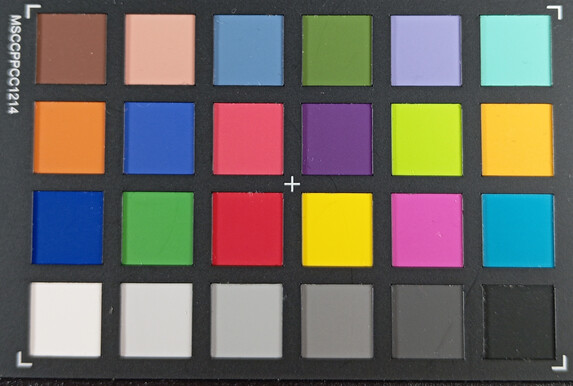
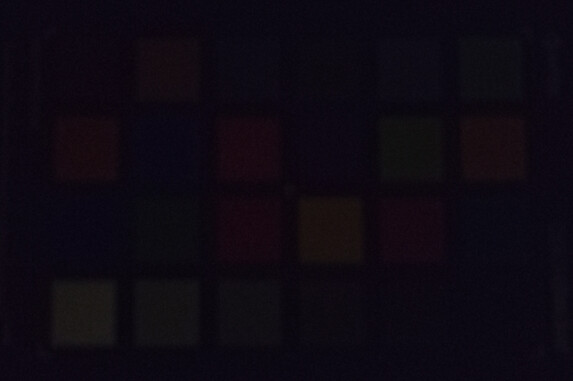
Accessories and warranty – No power supply included
The Redmi 12 doesn't come delivered with a power supply. Instead, the package includes a silicone case and a headset.
This phone currently isn't covered by Xiaomi's International Warranty Service, as only a select few of their phones are.
Input devices & operation – Accurate fingerprint sensor
The phone's 90-Hz screen can adjust its refresh rate automatically between four levels: 36 Hz/48 Hz/60 Hz/90 Hz. This lets the phone save energy when depicting a still image, while its refresh rate is also good enough to provide smooth operation with quick reaction speeds. The Redmi 12's reactive touchscreen is good and it is sensitive right up to the corners.
Xiaomi has hidden a fingerprint sensor on the right side of the phone within its standby button. It unlocks the phone almost immediately and very reliably. You can also unlock the device using your face - but it only scans 2D images, meaning it is a little susceptible to manipulation.
Display – High resolution, moderate brightness
The phone's IPS screen has a high resolution of 2,460 x 1,080 pixels - within this price range, it isn't uncommon to still see phones with a 720p resolution. Unfortunately, the Redmi 12 lacks a little in brightness, especially compared to the great AMOLED in the similarly priced Redmi Note 12 5G.
Its slightly raised black value also results in poor contrast levels. The display thankfully doesn't show any signs of PWM flickering, but in turn, it only offers moderate reaction speeds.
| |||||||||||||||||||||||||
Brightness Distribution: 95 %
Center on Battery: 449 cd/m²
Contrast: 898:1 (Black: 0.5 cd/m²)
ΔE ColorChecker Calman: 2.29 | ∀{0.5-29.43 Ø4.78}
ΔE Greyscale Calman: 3.7 | ∀{0.09-98 Ø5}
96.3% sRGB (Calman 2D)
Gamma: 2.254
CCT: 6198 K
| Xiaomi Redmi 12 IPS, 2460x1080, 6.8" | Xiaomi Redmi Note 12 5G AMOLED, 2400x1080, 6.7" | Samsung Galaxy A14 LTE PLS, 2408x1080, 6.6" | Nokia G22 IPS, 1600x720, 6.5" | Motorola Moto G23 IPS, 1600x720, 6.5" | |
|---|---|---|---|---|---|
| Screen | 39% | -91% | -2% | -22% | |
| Brightness middle (cd/m²) | 449 | 658 47% | 465 4% | 674 50% | 522 16% |
| Brightness (cd/m²) | 437 | 663 52% | 439 0% | 641 47% | 502 15% |
| Brightness Distribution (%) | 95 | 98 3% | 89 -6% | 90 -5% | 91 -4% |
| Black Level * (cd/m²) | 0.5 | 0.47 6% | 0.43 14% | 0.47 6% | |
| Contrast (:1) | 898 | 989 10% | 1567 74% | 1111 24% | |
| Colorchecker dE 2000 * | 2.29 | 1.4 39% | 8.5 -271% | 4.45 -94% | 4.63 -102% |
| Colorchecker dE 2000 max. * | 4.49 | 2.7 40% | 15.8 -252% | 7.41 -65% | 8.59 -91% |
| Greyscale dE 2000 * | 3.7 | 1.7 54% | 11.8 -219% | 5.1 -38% | 5.2 -41% |
| Gamma | 2.254 98% | 2.23 99% | 2.2 100% | 2.072 106% | 2.296 96% |
| CCT | 6198 105% | 6504 100% | 10757 60% | 7799 83% | 7832 83% |
* ... smaller is better
Screen Flickering / PWM (Pulse-Width Modulation)
| Screen flickering / PWM not detected | |||
In comparison: 53 % of all tested devices do not use PWM to dim the display. If PWM was detected, an average of 8108 (minimum: 5 - maximum: 343500) Hz was measured. | |||
In our measurements using a spectrophotometer and the software CalMAN, we noted a minimal yellow tint when depicting white tones, which also represents the screen's largest deviation to the reference color space. Colors are generally depicted very well and the color profile "standard" seems to be the most accurate.
Display Response Times
| ↔ Response Time Black to White | ||
|---|---|---|
| 17.2 ms ... rise ↗ and fall ↘ combined | ↗ 9.9 ms rise | |
| ↘ 7.3 ms fall | ||
| The screen shows good response rates in our tests, but may be too slow for competitive gamers. In comparison, all tested devices range from 0.1 (minimum) to 240 (maximum) ms. » 38 % of all devices are better. This means that the measured response time is better than the average of all tested devices (20.2 ms). | ||
| ↔ Response Time 50% Grey to 80% Grey | ||
| 34 ms ... rise ↗ and fall ↘ combined | ↗ 18.7 ms rise | |
| ↘ 15.3 ms fall | ||
| The screen shows slow response rates in our tests and will be unsatisfactory for gamers. In comparison, all tested devices range from 0.165 (minimum) to 636 (maximum) ms. » 45 % of all devices are better. This means that the measured response time is similar to the average of all tested devices (31.6 ms). | ||
Performance – Enough for everyday use
The installed MediaTek Helio G88 is a typical SoC for cheaper mid-range phones. In our comparison field, the device did quite well in most of the benchmarks - it only had to admit defeat to the Redmi Note 12 5G.
In everyday use, you can't fully avoid some dropped frames but when manoeuvring the system, they don't happen often. More complex apps overwhelm the phone quite quickly.
| Antutu v9 - Total Score | |
| Average of class Smartphone (99654 - 2056989, n=26, last 2 years) | |
| Xiaomi Redmi 12 | |
| Average Mediatek Helio G88 (259233 - 272388, n=2) | |
| Xiaomi Redmi Note 12 5G | |
| CrossMark - Overall | |
| Average of class Smartphone (187 - 2674, n=123, last 2 years) | |
| Xiaomi Redmi Note 12 5G | |
| Samsung Galaxy A14 LTE | |
| Xiaomi Redmi 12 | |
| Average Mediatek Helio G88 (319 - 326, n=3) | |
| UL Procyon AI Inference for Android - Overall Score NNAPI | |
| Average of class Smartphone (3769 - 81594, n=135, last 2 years) | |
| Xiaomi Redmi Note 12 5G | |
| Average Mediatek Helio G88 (3367 - 5025, n=4) | |
| Samsung Galaxy A14 LTE | |
| Xiaomi Redmi 12 | |
The phone did well for its price-range in the graphics benchmarks, too. However, it quickly becomes clear that the SoC is better suited for a 720p screen, as the corresponding phones within our comparison field did much better in the onscreen tests.
GFXBench (DX / GLBenchmark) 2.7: T-Rex Onscreen | 1920x1080 T-Rex Offscreen
GFXBench 3.0: on screen Manhattan Onscreen OGL | 1920x1080 1080p Manhattan Offscreen
GFXBench 3.1: on screen Manhattan ES 3.1 Onscreen | 1920x1080 Manhattan ES 3.1 Offscreen
GFXBench: on screen Car Chase Onscreen | 1920x1080 Car Chase Offscreen | on screen Aztec Ruins High Tier Onscreen | 2560x1440 Aztec Ruins High Tier Offscreen | on screen Aztec Ruins Normal Tier Onscreen | 1920x1080 Aztec Ruins Normal Tier Offscreen | 3840x2160 4K Aztec Ruins High Tier Offscreen
| 3DMark / Wild Life Extreme Unlimited | |
| Motorola Moto G23 | |
| Xiaomi Redmi 12 | |
| Samsung Galaxy A14 LTE | |
| Nokia G22 | |
| Xiaomi Redmi Note 12 5G | |
| 3DMark / Wild Life Extreme | |
| Motorola Moto G23 | |
| Xiaomi Redmi 12 | |
| Samsung Galaxy A14 LTE | |
| Nokia G22 | |
| Xiaomi Redmi Note 12 5G | |
| 3DMark / Wild Life Unlimited Score | |
| Motorola Moto G23 | |
| Xiaomi Redmi 12 | |
| Samsung Galaxy A14 LTE | |
| Nokia G22 | |
| Xiaomi Redmi Note 12 5G | |
| 3DMark / Wild Life Score | |
| Motorola Moto G23 | |
| Xiaomi Redmi 12 | |
| Samsung Galaxy A14 LTE | |
| Nokia G22 | |
| Xiaomi Redmi Note 12 5G | |
| 3DMark / Sling Shot Extreme (Vulkan) Unlimited Physics | |
| Xiaomi Redmi Note 12 5G | |
| Motorola Moto G23 | |
| Samsung Galaxy A14 LTE | |
| Xiaomi Redmi 12 | |
| 3DMark / Sling Shot Extreme (Vulkan) Unlimited Graphics | |
| Xiaomi Redmi Note 12 5G | |
| Motorola Moto G23 | |
| Xiaomi Redmi 12 | |
| Samsung Galaxy A14 LTE | |
| 3DMark / Sling Shot Extreme (Vulkan) Unlimited | |
| Xiaomi Redmi Note 12 5G | |
| Motorola Moto G23 | |
| Xiaomi Redmi 12 | |
| Samsung Galaxy A14 LTE | |
| 3DMark / Sling Shot Extreme (ES 3.1) Unlimited Physics | |
| Xiaomi Redmi Note 12 5G | |
| Motorola Moto G23 | |
| Samsung Galaxy A14 LTE | |
| Xiaomi Redmi 12 | |
| 3DMark / Sling Shot Extreme (ES 3.1) Unlimited Graphics | |
| Xiaomi Redmi Note 12 5G | |
| Motorola Moto G23 | |
| Samsung Galaxy A14 LTE | |
| Xiaomi Redmi 12 | |
| 3DMark / Sling Shot Extreme (ES 3.1) Unlimited | |
| Xiaomi Redmi Note 12 5G | |
| Motorola Moto G23 | |
| Samsung Galaxy A14 LTE | |
| Xiaomi Redmi 12 | |
| GFXBench (DX / GLBenchmark) 2.7 / T-Rex Onscreen | |
| Xiaomi Redmi Note 12 5G | |
| Motorola Moto G23 | |
| Xiaomi Redmi 12 | |
| Samsung Galaxy A14 LTE | |
| Nokia G22 | |
| GFXBench (DX / GLBenchmark) 2.7 / T-Rex Offscreen | |
| Xiaomi Redmi Note 12 5G | |
| Xiaomi Redmi 12 | |
| Motorola Moto G23 | |
| Samsung Galaxy A14 LTE | |
| Nokia G22 | |
| GFXBench 3.0 / Manhattan Onscreen OGL | |
| Motorola Moto G23 | |
| Xiaomi Redmi Note 12 5G | |
| Nokia G22 | |
| Xiaomi Redmi 12 | |
| Samsung Galaxy A14 LTE | |
| GFXBench 3.0 / 1080p Manhattan Offscreen | |
| Xiaomi Redmi Note 12 5G | |
| Xiaomi Redmi 12 | |
| Motorola Moto G23 | |
| Samsung Galaxy A14 LTE | |
| Nokia G22 | |
| GFXBench 3.1 / Manhattan ES 3.1 Onscreen | |
| Motorola Moto G23 | |
| Xiaomi Redmi Note 12 5G | |
| Nokia G22 | |
| Xiaomi Redmi 12 | |
| Samsung Galaxy A14 LTE | |
| GFXBench 3.1 / Manhattan ES 3.1 Offscreen | |
| Xiaomi Redmi Note 12 5G | |
| Xiaomi Redmi 12 | |
| Motorola Moto G23 | |
| Samsung Galaxy A14 LTE | |
| Nokia G22 | |
| GFXBench / Car Chase Onscreen | |
| Motorola Moto G23 | |
| Xiaomi Redmi Note 12 5G | |
| Nokia G22 | |
| Samsung Galaxy A14 LTE | |
| Xiaomi Redmi 12 | |
| GFXBench / Car Chase Offscreen | |
| Xiaomi Redmi Note 12 5G | |
| Xiaomi Redmi 12 | |
| Motorola Moto G23 | |
| Samsung Galaxy A14 LTE | |
| Nokia G22 | |
| GFXBench / Aztec Ruins High Tier Onscreen | |
| Xiaomi Redmi Note 12 5G | |
| Motorola Moto G23 | |
| Nokia G22 | |
| Samsung Galaxy A14 LTE | |
| Xiaomi Redmi 12 | |
| GFXBench / Aztec Ruins High Tier Offscreen | |
| Xiaomi Redmi Note 12 5G | |
| Xiaomi Redmi 12 | |
| Motorola Moto G23 | |
| Samsung Galaxy A14 LTE | |
| Nokia G22 | |
| GFXBench / Aztec Ruins Normal Tier Onscreen | |
| Xiaomi Redmi Note 12 5G | |
| Motorola Moto G23 | |
| Nokia G22 | |
| Xiaomi Redmi 12 | |
| Samsung Galaxy A14 LTE | |
| GFXBench / Aztec Ruins Normal Tier Offscreen | |
| Xiaomi Redmi Note 12 5G | |
| Xiaomi Redmi 12 | |
| Motorola Moto G23 | |
| Samsung Galaxy A14 LTE | |
| Nokia G22 | |
| GFXBench / 4K Aztec Ruins High Tier Offscreen | |
| Xiaomi Redmi Note 12 5G | |
| Motorola Moto G23 | |
| Xiaomi Redmi 12 | |
| Samsung Galaxy A14 LTE | |
| Nokia G22 | |
The Redmi 12 isn't the best at surfing the internet: You quite often have to wait a bit for pages to load. Images take their time too, even with over 1-GBit performance. Other devices in this price-range are often just a bit speedier.
| Jetstream 2 - 2.0 Total Score | |
| Average of class Smartphone (23.8 - 387, n=149, last 2 years) | |
| Xiaomi Redmi Note 12 5G (Chrome 113.0.5672.76) | |
| Samsung Galaxy A14 LTE (Chrome 114) | |
| Average Mediatek Helio G88 (28.1 - 48, n=4) | |
| Xiaomi Redmi 12 (Chrome 115) | |
| Speedometer 2.0 - Result 2.0 | |
| Average of class Smartphone (15.2 - 643, n=122, last 2 years) | |
| Xiaomi Redmi Note 12 5G (Chrome 113.0.5672.76) | |
| Samsung Galaxy A14 LTE (Chrome 114) | |
| Average Mediatek Helio G88 (20.6 - 27.5, n=3) | |
| Xiaomi Redmi 12 (Chrome 115) | |
| WebXPRT 4 - Overall | |
| Average of class Smartphone (27 - 306, n=145, last 2 years) | |
| Xiaomi Redmi Note 12 5G (Chrome 113.0.5672.76) | |
| Samsung Galaxy A14 LTE (Chrome 114) | |
| Average Mediatek Helio G88 (31 - 54, n=3) | |
| Xiaomi Redmi 12 (Chrome 115) | |
| WebXPRT 3 - Overall | |
| Average of class Smartphone (38 - 380, n=31, last 2 years) | |
| Xiaomi Redmi Note 12 5G (Chrome 113.0.5672.76) | |
| Samsung Galaxy A14 LTE (Chrome 114) | |
| Average Mediatek Helio G88 (43 - 53, n=3) | |
| Xiaomi Redmi 12 (Chrome 115) | |
| Octane V2 - Total Score | |
| Average of class Smartphone (2228 - 121337, n=197, last 2 years) | |
| Xiaomi Redmi Note 12 5G (Chrome 113.0.5672.76) | |
| Motorola Moto G23 (Chrome 111) | |
| Samsung Galaxy A14 LTE (Chrome 114) | |
| Nokia G22 (Chrome 112) | |
| Average Mediatek Helio G88 (7611 - 15102, n=7) | |
| Xiaomi Redmi 12 (Chrome 115) | |
| Mozilla Kraken 1.1 - Total | |
| Xiaomi Redmi 12 (Chrome 115) | |
| Average Mediatek Helio G88 (2743 - 5573, n=4) | |
| Samsung Galaxy A14 LTE (Chrome 114) | |
| Xiaomi Redmi Note 12 5G (Chrome 113.0.5672.76) | |
| Average of class Smartphone (257 - 28190, n=154, last 2 years) | |
* ... smaller is better
The eMMC flash in the Xiaomi Redmi 12 is a bit slow. Although it is still acceptable within this price-range, there are a few examples of phones with quicker flash which can transfer files and open apps quicker, such as the Redmi Note 12 5G or the Nokia G22.
| Xiaomi Redmi 12 | Xiaomi Redmi Note 12 5G | Samsung Galaxy A14 LTE | Nokia G22 | Motorola Moto G23 | Average 128 GB eMMC Flash | Average of class Smartphone | |
|---|---|---|---|---|---|---|---|
| AndroBench 3-5 | 75% | -28% | 83% | -3% | -19% | 417% | |
| Sequential Read 256KB (MB/s) | 300 | 520.09 73% | 298.69 0% | 881 194% | 282.4 -6% | 300 ? 0% | 2228 ? 643% |
| Sequential Write 256KB (MB/s) | 272.5 | 505.55 86% | 200.17 -27% | 367 35% | 244.6 -10% | 195.1 ? -28% | 1852 ? 580% |
| Random Read 4KB (MB/s) | 84.8 | 170.61 101% | 55.9 -34% | 131 54% | 100.2 18% | 85.9 ? 1% | 296 ? 249% |
| Random Write 4KB (MB/s) | 115 | 161.26 40% | 55.86 -51% | 172 50% | 100.5 -13% | 58.1 ? -49% | 339 ? 195% |
Games – Mostly just 30 fps
When gaming, you really shouldn't choose anything more than 30 fps. Of course, there will be some games that can manage 60 fps, but on more complex games such as PUBG Mobile, you can't really get many more frames - even at low detail settings.
We also couldn't achieve anything better than 30 fps and the lowest resolution setting while playing Diablo: Immortal. Furthermore, we noted a graphics bug which renders the game unplayable. We measured the frame rates using GameBench.
Controlling games using the touchscreen and the position sensor worked reliably.
Emissions – The Redmi 12 doesn't get all too warm
Temperature
We measured a peak case temperature of 44.1 °C. This can be felt, but it isn't yet critical. This doesn't have an effect on the device's speed - even after 20 runs of a complex benchmark, the phone still had access to 96 % of its original performance.
(±) The maximum temperature on the upper side is 44 °C / 111 F, compared to the average of 35.2 °C / 95 F, ranging from 21.9 to 247 °C for the class Smartphone.
(±) The bottom heats up to a maximum of 44.1 °C / 111 F, compared to the average of 34 °C / 93 F
(+) In idle usage, the average temperature for the upper side is 24.5 °C / 76 F, compared to the device average of 32.9 °C / 91 F.
3DMark Wild Life Stress Test
| 3DMark | |
| Wild Life Stress Test Stability | |
| Motorola Moto G23 | |
| Nokia G22 | |
| Samsung Galaxy A14 LTE | |
| Samsung Galaxy A14 LTE | |
| Xiaomi Redmi 12 | |
| Wild Life Extreme Stress Test | |
| Xiaomi Redmi 12 | |
| Samsung Galaxy A14 LTE | |
Speaker
The small speaker on the bottom corner of the device does its job quite well - it sounds relatively clear and it doesn't exaggerate the highs. Of course, you should by no means expect some sort of HiFi system, but it is definitely enough to watch some videos or listen to some music occasionally.
The phone has a 3.5 mm jack and Bluetooth, which you can use to connect external audio devices. A great variety of codecs is supported: Aside from SBC and AAC, it also supports all the important aptX codecs, LDAC and LHDC up to version 5.
Xiaomi Redmi 12 audio analysis
(±) | speaker loudness is average but good (79.4 dB)
Bass 100 - 315 Hz
(-) | nearly no bass - on average 31.5% lower than median
(±) | linearity of bass is average (9.6% delta to prev. frequency)
Mids 400 - 2000 Hz
(+) | balanced mids - only 4.8% away from median
(±) | linearity of mids is average (7.8% delta to prev. frequency)
Highs 2 - 16 kHz
(+) | balanced highs - only 3.5% away from median
(+) | highs are linear (4.9% delta to prev. frequency)
Overall 100 - 16.000 Hz
(±) | linearity of overall sound is average (24% difference to median)
Compared to same class
» 55% of all tested devices in this class were better, 8% similar, 37% worse
» The best had a delta of 11%, average was 35%, worst was 134%
Compared to all devices tested
» 71% of all tested devices were better, 6% similar, 22% worse
» The best had a delta of 4%, average was 24%, worst was 134%
Motorola Moto G23 audio analysis
(±) | speaker loudness is average but good (77.9 dB)
Bass 100 - 315 Hz
(-) | nearly no bass - on average 25.7% lower than median
(±) | linearity of bass is average (9.3% delta to prev. frequency)
Mids 400 - 2000 Hz
(±) | higher mids - on average 5.1% higher than median
(+) | mids are linear (5.2% delta to prev. frequency)
Highs 2 - 16 kHz
(+) | balanced highs - only 4.1% away from median
(±) | linearity of highs is average (8.4% delta to prev. frequency)
Overall 100 - 16.000 Hz
(±) | linearity of overall sound is average (22.3% difference to median)
Compared to same class
» 46% of all tested devices in this class were better, 7% similar, 47% worse
» The best had a delta of 11%, average was 35%, worst was 134%
Compared to all devices tested
» 64% of all tested devices were better, 6% similar, 30% worse
» The best had a delta of 4%, average was 24%, worst was 134%
Battery life – Good stamina
Power consumption
The Redmi 12 seems to be quite frugal under low and very low load, but under high load, it can use quite a bit of power at times.
In order to recharge the device, a charging system with up to 18 watts is installed. While the phone doesn't come with a charger, we used a few chargers from different phones and they were all identified by the Xiaomi Redmi 12, enabling the phone to be charged quickly. It takes a maximum of 2:15 hours to charge the battery completely.
| Off / Standby | |
| Idle | |
| Load |
|
Key:
min: | |
| Xiaomi Redmi 12 5000 mAh | Xiaomi Redmi Note 12 5G 5000 mAh | Samsung Galaxy A14 LTE 5000 mAh | Average Mediatek Helio G88 | Average of class Smartphone | |
|---|---|---|---|---|---|
| Power Consumption | -6% | -22% | -24% | -21% | |
| Idle Minimum * (Watt) | 1 | 0.99 1% | 0.89 11% | 1.11 ? -11% | 0.842 ? 16% |
| Idle Average * (Watt) | 1.2 | 1.98 -65% | 2.31 -93% | 1.803 ? -50% | 1.439 ? -20% |
| Idle Maximum * (Watt) | 1.5 | 2.02 -35% | 2.34 -56% | 2.14 ? -43% | 1.624 ? -8% |
| Load Average * (Watt) | 4.2 | 3.35 20% | 4.11 2% | 5 ? -19% | 7.03 ? -67% |
| Load Maximum * (Watt) | 8.9 | 4.72 47% | 6.46 27% | 8.69 ? 2% | 11.3 ? -27% |
* ... smaller is better
Power consumption: Geekbench (150 cd/m²)
Power consumption: GFXBench (150 cd/m²)
Runtimes
In our WLAN test, the Xiaomi Redmi 12 did quite well with average runtimes of 13:23 hours. You can definitely manage a whole working day on this device, but there are certainly a few other phones within the price range that enable even longer runtimes. Other use scenarios such as watching videos or high load also showed good results, meaning the Redmi phone delivered a good score in total regarding runtimes.
| Xiaomi Redmi 12 5000 mAh | Xiaomi Redmi Note 12 5G 5000 mAh | Samsung Galaxy A14 LTE 5000 mAh | Nokia G22 5050 mAh | Motorola Moto G23 5000 mAh | |
|---|---|---|---|---|---|
| Battery runtime | -1% | -5% | 31% | 43% | |
| Reader / Idle (h) | 23.8 | 27.8 17% | 19.5 -18% | ||
| H.264 (h) | 18.1 | 17.8 -2% | 17.4 -4% | ||
| WiFi v1.3 (h) | 13.4 | 10.8 -19% | 14.9 11% | 17.5 31% | 19.2 43% |
| Load (h) | 6.4 | 6.5 2% | 5.8 -9% |
Pros
Cons
Verdict – Attractive and cheap with some highlights
The Xiaomi Redmi 12 looks great and comes with lots of storage space. A few positive aspects deserve to be named, such as its IR blaster and FM radio reception. It also comes with the necessary headset to use as a substitute for an antenna. The inexpensive mid-range phone also offers good runtimes and very precise locating.
The camera is fitted with three decent lenses, making it flexible and - for the price - really quite okay. Its screen could be a little brighter, but all-in-all, it can depict colors quite well. In case you enjoy listening to music, the phone features decent speakers, lots of Bluetooth codecs as well as a 3.5 mm jack.
We find all the bloatware to be a little annoying, which Xiaomi has pre-installed onto the phone. This is even more of a shame because the phone is supposed to receive long and regular operating system updates as well. The smartphone doesn't come with a charger, but this shouldn't be too big an issue, as the device is compatible with all the usual chargers.
The Xiaomi Redmi 12 is an attractive and inexpensive smartphone which may not include 5G, but it can offer lots of storage and precise locating in return.
One of the phone's main competitors actually comes from the same manufacturer: The Xiaomi Redmi Note 12 5G offers faster memory, better performance and 5G. It just isn't quite as nice in looks. If you are looking to spend even less money, then it may be worth taking a look at the Nokia G22.
Price and availability
Xiaomi Redmi 12
- 08/06/2023 v7 (old)
Florian Schmitt
Transparency
The selection of devices to be reviewed is made by our editorial team. The test sample was provided to the author as a loan by the manufacturer or retailer for the purpose of this review. The lender had no influence on this review, nor did the manufacturer receive a copy of this review before publication. There was no obligation to publish this review. As an independent media company, Notebookcheck is not subjected to the authority of manufacturers, retailers or publishers.
This is how Notebookcheck is testing
Every year, Notebookcheck independently reviews hundreds of laptops and smartphones using standardized procedures to ensure that all results are comparable. We have continuously developed our test methods for around 20 years and set industry standards in the process. In our test labs, high-quality measuring equipment is utilized by experienced technicians and editors. These tests involve a multi-stage validation process. Our complex rating system is based on hundreds of well-founded measurements and benchmarks, which maintains objectivity. Further information on our test methods can be found here.




